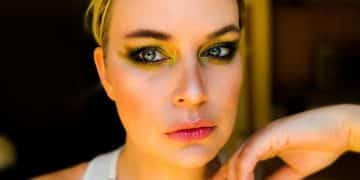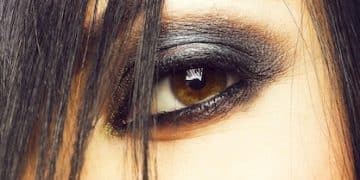Mastering the Art of Blending: Your Ultimate Makeup Tutorial for a Seamless Finish

Advertisements
Mastering the art of blending in makeup is essential for achieving a flawless, airbrushed look; this tutorial provides a comprehensive guide to blending techniques, products, and tools for a seamless finish every time, regardless of your skill level.
Advertisements
Achieving a flawless makeup look is often about more than just the products you use; it’s about the technique, and mastering the art of blending is at the heart of it all. This tutorial will guide you through everything you need to know to create a seamless finish every time.
Understanding the Basics of Makeup Blending
Advertisements
Blending is the process of seamlessly merging different makeup products together to create a smooth, natural-looking finish. Whether it’s foundation, eyeshadow, or blush, proper blending ensures that there are no harsh lines or visible edges, giving your makeup a professional and polished appearance.
Why is blending so important? Because it creates a unified look and avoids the dreaded “cakey” effect. When makeup is not properly blended, it can sit on top of the skin, emphasizing texture and fine lines. Blending, on the other hand, allows the products to melt into the skin, creating a more youthful and radiant complexion.
The Importance of Quality Makeup Tools
Investing in good-quality makeup brushes and sponges is the first step toward mastering the art of blending. These tools are designed to distribute product evenly and effortlessly, making the blending process smoother and more efficient.
- Makeup Brushes: Different brushes are designed for different purposes. Fluffy brushes are ideal for blending eyeshadow, while denser brushes are better for applying and blending foundation.
- Makeup Sponges: Sponges, like the Beautyblender, are excellent for creating a seamless finish with liquid and cream products. They can be used damp or dry, depending on the desired level of coverage.
- Brush Maintenance: Regularly cleaning your brushes is essential for hygiene and performance. Dirty brushes can harbor bacteria and affect the application of your makeup.
Choosing the right tools and keeping them in good condition will significantly improve your blending skills and the overall look of your makeup.
In summary, understanding the basics of makeup blending, including its importance and the role of quality tools, is fundamental to achieving a flawless and professional finish. With the right techniques and tools, you can transform your makeup routine and create a seamless look every time.
Preparing Your Skin for a Flawless Blend
Before diving into the blending process, it’s crucial to prepare your skin properly. A smooth and hydrated canvas will make the blending process much easier and result in a more natural-looking finish. Proper skincare is the foundation for flawless makeup.
What steps should you take to prep your skin? Start with cleansing to remove any dirt, oil, or makeup residue. Follow up with a hydrating toner to balance your skin’s pH. Finally, apply a moisturizer to hydrate and plump up the skin.

The Role of Primer in Blending
Primer is an often overlooked but essential step in preparing your skin for makeup. It creates a smooth base, fills in pores and fine lines, and helps your makeup last longer. Different primers are formulated for different skin types and concerns.
Using the right primer can make a world of difference in how your makeup blends and wears throughout the day. It can also help control oil production, minimize pores, and even out skin texture, providing an ideal canvas for your makeup application.
- Silicone-Based Primers: Ideal for filling in pores and creating a smooth surface.
- Water-Based Primers: Perfect for hydrating dry skin and preventing makeup from clinging to dry patches.
- Color-Correcting Primers: Help to neutralize redness or brighten dull skin.
Selecting the right primer for your skin type is crucial for achieving a flawless and long-lasting makeup look.
In conclusion, preparing your skin with proper cleansing, hydration, and primer application is essential for achieving a flawless blend. A well-prepped canvas allows makeup to effortlessly glide onto the skin, resulting in a smooth, natural-looking finish that lasts all day.
Foundation Blending Techniques for a Natural Look
Achieving a natural-looking foundation finish is all about the way you blend. The goal is for the foundation to seamlessly merge with your skin, creating an even and uniform complexion without looking heavy or cakey. Mastering the art of foundation blending is key to a flawless base.
There are several techniques you can use to blend your foundation effectively. These include stippling, buffing, and using a damp makeup sponge. Each technique offers a different level of coverage and finish.
Choosing the Right Foundation Formula
The type of foundation you choose will also impact how easily it blends into your skin. Liquid foundations are generally easier to blend than thicker cream formulas. Powder foundations can be more challenging to blend seamlessly, especially on dry skin.
Consider your skin type and the level of coverage you desire when selecting a foundation formula. Lighter, more hydrating formulas tend to blend more effortlessly, while heavier formulas may require more effort to achieve a natural-looking finish.
- Liquid Foundations: Versatile and easy to blend, suitable for most skin types.
- Cream Foundations: Offer more coverage and are ideal for dry or mature skin.
- Powder Foundations: Best for oily skin, but can be challenging to blend on dry skin.
Selecting the right foundation formula for your skin type is crucial for achieving a smooth, natural, and well-blended finish.
Ultimately, mastering foundation blending techniques involves selecting the right formula, using the appropriate tools, and practicing different blending methods to find what works best for your skin and desired look. With the right approach, you can achieve a flawless and natural-looking foundation finish every time.
Concealer Blending Secrets for a Bright, Even Complexion
Concealer is a makeup bag essential for covering blemishes, dark circles, and imperfections. However, applying concealer correctly is just as important as using the right shade. Proper blending ensures that the concealer seamlessly integrates with your foundation, creating a bright and even complexion. Poorly blended concealer can look patchy and unnatural.
When blending concealer, use a light hand and focus on pressing the product into the skin rather than rubbing. Rubbing can disrupt the foundation underneath and cause the concealer to look streaky.
The Best Tools for Concealer Blending
The tools you use to blend your concealer can significantly impact the end result. Small, pointed blending brushes and damp makeup sponges are ideal for achieving a seamless finish.
Using the right tools allows you to work the concealer into the skin without creating harsh lines or creases. It also helps to maintain the coverage while ensuring that the product blends seamlessly with the surrounding foundation.
- Small Blending Brushes: Ideal for precise application and blending in hard-to-reach areas.
- Damp Makeup Sponges: Excellent for creating a seamless finish and preventing creasing.
- Fingertips: Can be used to gently warm and press the product into the skin for a natural look.
Selecting the right tools for concealer blending ensures a flawless and natural-looking result.
In conclusion, mastering concealer blending involves using the right techniques, selecting the best tools, and focusing on pressing the product into the skin for a seamless finish. With the right approach, you can achieve a bright, even complexion that looks natural and flawless.
Achieving a Seamless Eyeshadow Blend
Eyeshadow blending is a crucial skill for creating stunning eye makeup looks. Seamlessly blended eyeshadow enhances the eyes, adds depth and dimension, and prevents harsh lines, giving a professional and polished appearance.
To achieve a seamless eyeshadow blend, start with a good eyeshadow primer to create a smooth base and ensure that your eyeshadows adhere properly. Then, use fluffy blending brushes to gently diffuse the colors together.
The Importance of Using the Right Brushes
The type of brushes you use can make or break your eyeshadow blend. Fluffy, tapered blending brushes are ideal for creating a seamless gradient between different eyeshadow shades.
Investing in high-quality blending brushes is essential for achieving professional-looking results. These brushes are designed to gently diffuse the colors, preventing harsh lines and creating a smooth transition between shades.
- Fluffy Blending Brushes: Perfect for blending eyeshadows in the crease and outer corners of the eyes.
- Pencil Brushes: Ideal for precise application and smudging along the lash line.
- Flat Shader Brushes: Used to pack eyeshadow onto the lid.
Choosing the right brushes is the key to achieving a seamless and stunning eyeshadow blend.
In summary, achieving a seamless eyeshadow blend requires using the right techniques, starting with a good primer, and investing in high-quality brushes designed for blending. By gently diffusing the colors together, you can create a professional and polished eye makeup look that enhances your natural beauty.
Blush and Bronzer Blending for a Natural Flush of Color
Blush and bronzer are essential for adding warmth, dimension, and a healthy flush of color to the face. However, poorly blended blush and bronzer can look unnatural and harsh. Proper blending ensures that these products seamlessly integrate with your foundation, creating a natural and radiant complexion.
When blending blush and bronzer, use a light hand and focus on sweeping the product onto the skin in a soft, circular motion. Start with a small amount of product and build up the color gradually until you achieve the desired intensity.
Tips for Avoiding a Harsh Blush Line
One of the most common makeup mistakes is applying blush too heavily in a concentrated area. To avoid a harsh blush line, use a large, fluffy brush and tap off any excess product before applying it to your cheeks.
Also, be sure to smile while applying blush to find the apples of your cheeks. Then, blend the blush upwards towards your temples for a natural and lifted look.
- Use a Fluffy Brush: This will help to diffuse the color and prevent harsh lines.
- Tap Off Excess Product: This ensures that you’re not applying too much color at once.
- Blend Upwards: This creates a natural and lifted look.
Following these tips will help you achieve a natural and radiant blush application every time.
In conclusion, mastering blush and bronzer blending involves using the right techniques, selecting the appropriate brushes, and focusing on sweeping the product onto the skin in a soft, circular motion. With the right approach, you can achieve a natural flush of color that enhances your complexion and adds warmth and dimension to your face.
| Key Point | Brief Description |
|---|---|
| ✨ Skin Prep | Cleanse, tone, and moisturize before applying makeup for a smooth base. |
| 🖌️ Quality Tools | Use the correct brushes and sponges for each product. Clean them regularly. |
| 💧 Blending Technique | Use light layers, stippling or swirling motions to blend products into the skin. |
| 🎨 Shade Selection | Choose shades that complement your skin tone for a natural look. |
Frequently Asked Questions (FAQ)
▼
Baking involves applying a thick layer of translucent powder over concealer, letting it sit for five to ten minutes to set, and then dusting it off. This technique brightens the under-eye area and prevents creasing.
▼
Use a gentle brush cleanser or mild soap and water. Swirl the brushes in the cleanser, rinse thoroughly, and lay flat to dry. Regular cleaning prevents bacteria buildup.
▼
Prep your skin with moisturizer and primer. Apply foundation in thin layers, blending well after each layer. Avoid using too much powder, which can emphasize texture.
▼
For covering blemishes, choose a concealer that matches your skin tone. For brightening under the eyes, select a shade one to two shades lighter than your skin tone.
▼
Start with neutral shades and a fluffy blending brush. Apply a transition shade to the crease, and use windshield wiper motions to blend the color evenly. Practice makes perfect!
Conclusion
Mastering the art of makeup blending is achievable with the right techniques, tools, and practice. By focusing on skin preparation, selecting quality products, and refining your blending skills, you can achieve a flawless and natural makeup look that enhances your beauty with confidence.





